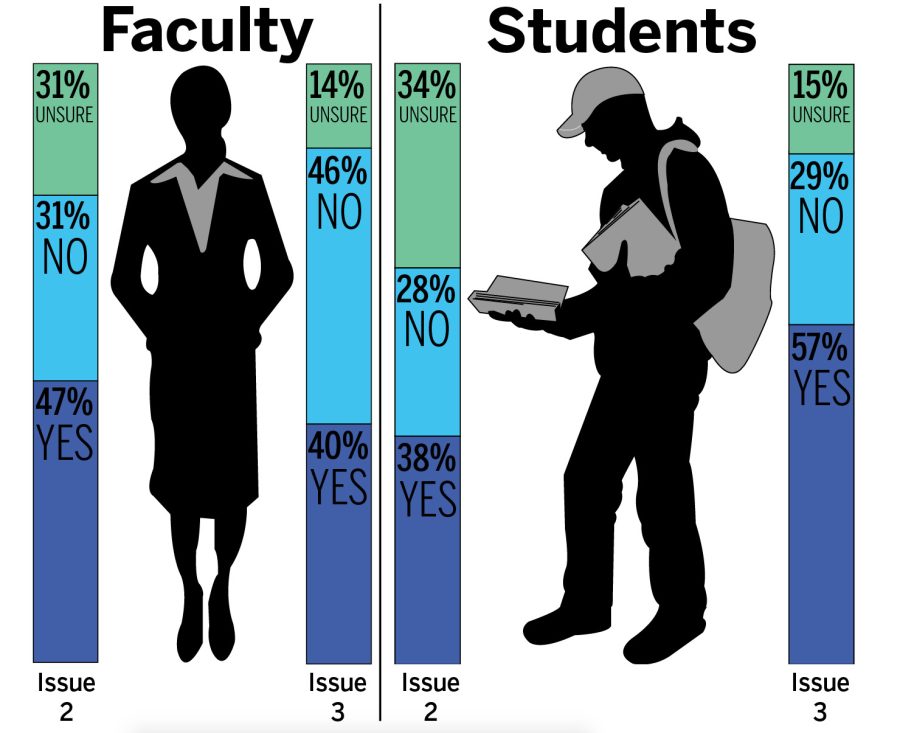Kent State students support Issue 3
October 28, 2015
A recent Kent State poll found 57 percent of student voters are in favor of Issue 3, which would allow for the commercial production and sale of marijuana for recreational and medicinal purposes.
In addition, 38 percent of student voters were in favor of Issue 2, which is an anti-monopoly amendment that would protect the initiative process from being used for personal economic benefit.
In an overwhelming response, the survey, commissioned by Kent State’s School of Journalism and Mass Communication in conjunction with the Department of Political Science and the Survey Research Lab, found the results were similar to those of the statewide polls on Issues 2 and 3.
In general, the survey reported, the campus population supports the idea of medical marijuana use with 86 percent in support and seven percent opposed. However, when it comes to personal use, the support drops down to 68 percent and the opposition rises to 23 percent.
The Survey
This survey follows the reports from Kent State and WKYC regarding Ohio’s support of Issues 2 and 3. However, the FlashPoll was sent exclusively to university undergraduates, graduates, faculty and staff.
Of those who received the survey, 22.4 percent responded — three times more than what the principle investigators were expecting.
Anthony Vander Horst, an associate professor of sociology, said the poll was unusually racially diverse, with participation from Caucasians, African Americans, Hispanics, Native Americans and Asians.
“Most of the time, you lose the smaller categories, so it was really exceptional to have Native American and Asian responses,” he said.
The margin of error for undergraduate student statistics is two percent, and the margin of error for faculty and staff is about three percent.
Issue 3
The FlashPoll revealed 57 percent of surveyed undergraduate voters were likely to vote in favor of passing Issue 3, whereas 29 percent were not in favor. Fifteen percent of students said they don’t know how they are going to vote.
If passed, Issue 3 would legalize recreational and medical marijuana usage for Ohioans and create ten growing facilities for commercial production of marijuana.
“For this survey, we had a random sample of the entire university community of undergraduate and graduate students, faculty and staff,” said Ryan Claassen, an associate professor of political science. “The Kent State poll indicated, not surprisingly, higher support of marijuana for personal use.”
Only 40 percent of faculty and staff were likely to vote in favor of passing Issue 3 with 46 percent against. Fourteen percent said they don’t know how they are going to vote.
“In terms of faculty and staff, we were surprised at how low the support was,” Claassen said. “Statewide was closer to 56 percent.”
Age is one of the underlying factors in deciding how people vote, he said. The younger someone is, the more likely he or she would be in favor of passing Issue 3.
Claassen also attributes Issue 3’s favorability to the ResponsibleOhio campaign.
“There is a big advertising campaign going on,” he said. “Ohio is getting lots of postcards on Issue 3. You’re seeing advertisements while you’re watching television. You might even see ‘Buddy’ waving to you from the corner.”
Issue 2
Issue 2 did not fare as well in the FlashPoll. The survey found 38 percent of likely undergraduate student voters are in favor of the amendment and 28 percent are against. Thirty-eight percent said they don’t know how they are going to vote on the issue.
Forty-seven percent of likely faculty and staff voters said they would vote “yes” on Issue 2, and 31 percent said they would vote against it. Twenty-two percent said they don’t know how they will vote.
Issue 2, the anti-monopoly amendment, is essentially trying to prevent a possible monopoly on marijuana sales in Ohio. If passed, it would also prohibit Issue 3 from becoming an amendment — even if Issue 3 is passed.
Rusty Schnellinger, a graduate sociology student, helped to construct the survey and said the language used might be the cause of uncertainty on the issue.
“We chose, rather than to summarize each one, we decided to use the exact language voters will see on the ballot,” Schnellinger said.
This would allow the poll results to better reflect the results they might see on election day.
What if both issues are passed?
Issues 2 and 3 are at the forefront of the discussion for the 2015 election in Ohio, and if both are passed, it will cause some serious controversy.
Issue 2’s aim is to negate any change brought on by Issue 3; Issue 3 would become unconstitutional if both issues are passed.
Issue 3 is a “citizen’s initiative” bill, meaning it was written by the people and had to gain a certain number of signatures before it was put on the ballot, while Issue 2 was written by lawmakers in response to the bill being on the ballot.
“It seems almost irrational voters would vote for both of these constitutional amendments,” Claassen said.
If both are passed, it is likely the issues will be brought to Ohio’s Supreme Court to undergo litigation.
Editor’s note: WKYC poll was a Kent State poll for the state of Ohio.
Hannah Armenta is the editor of The Kent Stater. Contact her at [email protected].

























